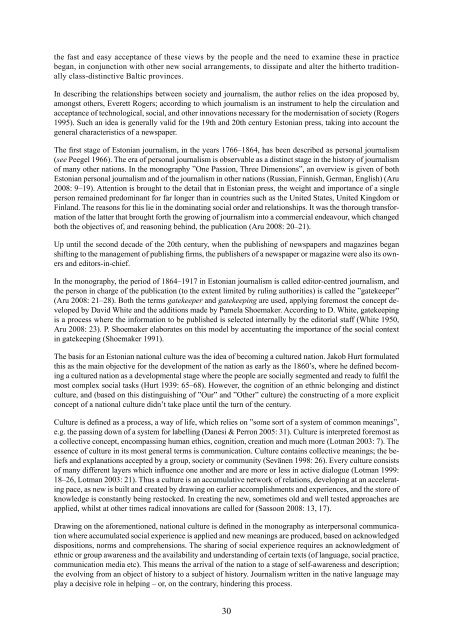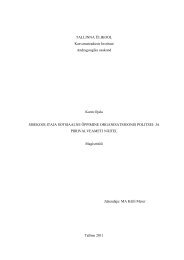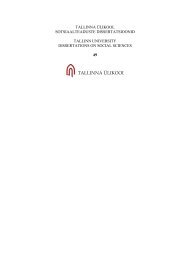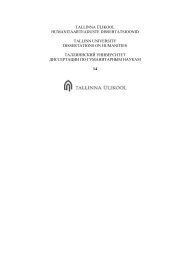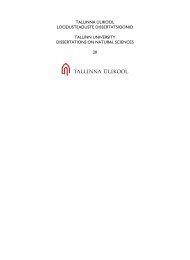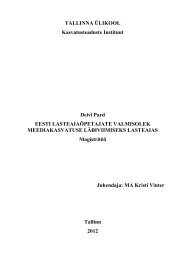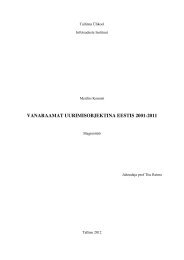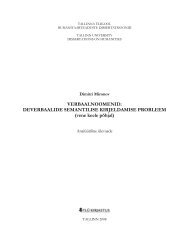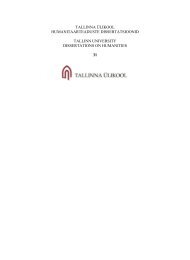You also want an ePaper? Increase the reach of your titles
YUMPU automatically turns print PDFs into web optimized ePapers that Google loves.
the fast and easy acceptance of these views by the people and the need to examine these in practice<br />
began, in conjunction with other new social arrangements, to dissipate and alter the hitherto traditionally<br />
class-distinctive Baltic provinces.<br />
In describing the relationships between society and journalism, the author relies on the idea proposed by,<br />
amongst others, Everett Rogers; according to which journalism is an instrument to help the circulation and<br />
acceptance of technological, social, and other innovations necessary for the modernisation of society (Rogers<br />
1995). Such an idea is generally valid for the 19th and 20th century Estonian press, taking into account the<br />
general characteristics of a newspaper.<br />
The first stage of Estonian journalism, in the years 1766–1864, has been described as personal journalism<br />
(see Peegel 1966). The era of personal journalism is observable as a distinct stage in the history of journalism<br />
of many other nations. In the monography ”One Passion, Three Dimensions”, an overview is given of both<br />
Estonian personal journalism and of the journalism in other nations (Russian, Finnish, German, English) (Aru<br />
2008: 9–19). Attention is brought to the detail that in Estonian press, the weight and importance of a single<br />
person remained predominant for far longer than in countries such as the United States, United Kingdom or<br />
Finland. The reasons for this lie in the dominating social order and relationships. It was the thorough transformation<br />
of the latter that brought forth the growing of journalism into a commercial endeavour, which changed<br />
both the objectives of, and reasoning behind, the publication (Aru 2008: 20–21).<br />
Up until the second decade of the 20th century, when the publishing of newspapers and magazines began<br />
shifting to the management of publishing firms, the publishers of a newspaper or magazine were also its owners<br />
and editors-in-chief.<br />
In the monography, the period of 1864–1917 in Estonian journalism is called editor-centred journalism, and<br />
the person in charge of the publication (to the extent limited by ruling authorities) is called the ”gatekeeper”<br />
(Aru 2008: 21–28). Both the terms gatekeeper and gatekeeping are used, applying foremost the concept developed<br />
by David White and the additions made by Pamela Shoemaker. According to D. White, gatekeeping<br />
is a process where the information to be published is selected internally by the editorial staff (White 1950,<br />
Aru 2008: 23). P. Shoemaker elaborates on this model by accentuating the importance of the social context<br />
in gatekeeping (Shoemaker 1991).<br />
The basis for an Estonian national culture was the idea of becoming a cultured nation. Jakob Hurt formulated<br />
this as the main objective for the development of the nation as early as the 1860’s, where he defined becoming<br />
a cultured nation as a developmental stage where the people are socially segmented and ready to fulfil the<br />
most complex social tasks (Hurt 1939: 65–68). However, the cognition of an ethnic belonging and distinct<br />
culture, and (based on this distinguishing of ”Our” and ”Other” culture) the constructing of a more explicit<br />
concept of a national culture didn’t take place until the turn of the century.<br />
Culture is defined as a process, a way of life, which relies on ”some sort of a system of common meanings”,<br />
e.g. the passing down of a system for labelling (Danesi & Perron 2005: 31). Culture is interpreted foremost as<br />
a collective concept, encompassing human ethics, cognition, creation and much more (Lotman 2003: 7). The<br />
essence of culture in its most general terms is communication. Culture contains collective meanings; the beliefs<br />
and explanations accepted by a group, society or community (Sevänen 1998: 26). Every culture consists<br />
of many different layers which influence one another and are more or less in active dialogue (Lotman 1999:<br />
18–26, Lotman 2003: 21). Thus a culture is an accumulative network of relations, developing at an accelerating<br />
pace, as new is built and created by drawing on earlier accomplishments and experiences, and the store of<br />
knowledge is constantly being restocked. In creating the new, sometimes old and well tested approaches are<br />
applied, whilst at other times radical innovations are called for (Sassoon 2008: 13, 17).<br />
Drawing on the aforementioned, national culture is defined in the monography as interpersonal communication<br />
where accumulated social experience is applied and new meanings are produced, based on acknowledged<br />
dispositions, norms and comprehensions. The sharing of social experience requires an acknowledgment of<br />
ethnic or group awareness and the availability and understanding of certain texts (of language, social practice,<br />
communication media etc). This means the arrival of the nation to a stage of self-awareness and description;<br />
the evolving from an object of history to a subject of history. Journalism written in the native language may<br />
play a decisive role in helping – or, on the contrary, hindering this process.<br />
30


